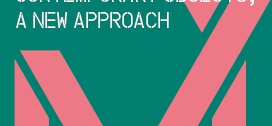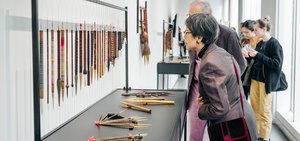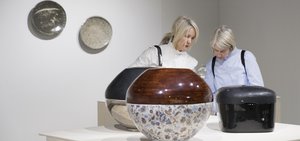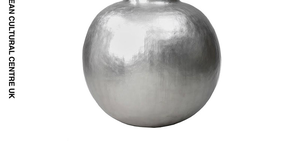Make Your Movements: Korean Contemporary Objects, A New Approach

The Korea Craft and Design Foundation with the Korean Cultural Centre UK (KCCUK) present Make Your Movements: Korean Contemporary Objects, A New Approach (1 August - 17 September 2016), an exhibition curated to showcase a new phase in Korean craft, each influenced by the concept of ‘movement’. Fabriker YongJin Chung JuCheol Yun Kyeok Kim SangHee Yun The exhibition at the KCCUK brings together 19 designers, makers and craftsmen from Korea whose collections range from 3D printed accessories and furniture to jewellery and ceramics. Curated by Kyoungrin Park, the show explores the theory of movement in craft, taking as a starting point the way craftsmen move during their creative work, and how a completed object leaves the hands of its maker imbued with their manual knowledge; it then travels to an exhibition hall, an art gallery or a store, therefore generating another movement.
Kyoungrin Park comments: “When we planned this exhibition we discussed the word ‘movement’. The primary meaning of ‘movement’ knows no immediate distinction in the East and the West. The definition of ‘movement’ in a Korean dictionary would state: ‘a change of a static posture or position or a change of a posture or a position.’ An English dictionary states: ‘movement involves changing position or going from one place to another’. The exhibition uses as its starting point the semantic layers hidden in this single word.” Park developed the curatorial statement to encompass eight key concepts:
1. Craftsmen design and make objects with their own hands.
2. Hand-made objects are imbued with their makers’ thoughts and physical knowledge.
3. Objects generate movements around them in their users and observers.
4. Objects have a performative quality: they command, and control such movements.
5. Crafts can be considered as a physical record and as receptacle of control and order.
‘Make Your Movements: Korean Contemporary Objects, A New Approach’ is an exhibition developed also as medium to communicate Korean culture to a different audience. To further contextualise the objects on display, Park was mindful to extend her curatorial vision to:
6. Objects made by craftsmen pursuing specificity instead of universality.
7. Objects contain their makers’ knowledge, and consequently Korean culture is embedded in them
8. When objects representative of a cultural context are displayed in a different culture, they become a communication tool.
In selecting the designers and their work for the exhibition, Park gives an overview of Korean crafts spanning both the traditional and the innovative, showcasing contextual methods and techniques that reflect both the changes in Korean culture and the idiosyncrasies of centuries old crafts solutions adapted to today’s society. From lacquered metal trays that double up as hanging pictures, to 3D printed objects that are highly manipulated by hand, ceramics taken to unprecedented levels of thinness to the point of becoming transparent, and furniture designed specifically for traditional market traders, this exhibition allows western viewers to immerse themselves in a world that is both exotic yet familiar, and invites them to interact with the physical qualities of the objects to appreciate their inner essence, in a near-performative exchange.
Craftsmen and Designers
Bomi Park: Instruments to connect one world to another Bomi Park introduces the ‘After Image’ series, a collection inspired by steel structures. The foldable table and chair offers a convenient solution for stall-holders in traditional Korean markets. She wanted to create a functional series of furniture to help this a disappearing traditional community.
Kiyeon Jeong: Objects that change depending on movement and use. Kiyeon Jeong’s moving objects are designed for eating and drinking – two of the most essential elements to maintaining life. They are the outcome of observation and careful consideration of mundane daily actions, that look at how eating utensils are used.
Sangmin Lee: Practice in daily life Experiences internalised by craftsmen over time and derived from daily actions. Lee’s main source of inspiration is found in the everyday; he crafts small objects, which are created through a thorough process of daily practice.
Kyeok Kim: Expansion of the physical body Kyeok Kim’s ‘Expansion of the physical body’ pushes the boundaries of the physicality of the body by crafting ‘body extensions’, made entirely of edible collagen material.
FABRIKR: Looking at things from a different angle through upcycling Established design studio FABRIKR showcases objects ‘re-born’. By using discarded pieces of fabrics FABRIKR gives shape to new aesthetics and pragmatic objects.
Deokho Kim: Basics and experiences Ceramic objects by Deokho Kim are created by mixing various colors to the purest white clay. He creates an object through the rotation of a spinning wheel, and completes the work by slowly trimming the surface until the marbled effect beautifully appears in a simple form. The designer has perfected the art of ceramic, which is based on the learning of the body – the knowledge of his hands, which comes from the manual repetition of rules and practice.
Inhwa Lee: Transparencies and light Inhwa Lee works with porcelain, and polishes her work to the highest degree so that the material becomes transparent and interacts with light. Through this process the designer has experimented with the effect of light on porcelain, which is manifested in a ‘marbling’ effect.
Kyungtaek Roh: Connecting with the World through Furniture Kyungtaek Roh’s practice has at its core the making of furniture based on the theme of ‘shells’. Shells imply internal development of flora and fauna. In his practice, shells are also representative of the many faces of individuals and society. Kyungtaek Roh creates furniture for everyday use with materials such as ceramics, leather, metal and wood.
Yong-Jin Chung: New Attempts using 3D related digital processing in metalwork Yongjin Chung has used various 3D techniques and 3D programs in his career. He currently uses digital processing by adopting 3D related digital processing such as 3D CAD and Laser cut as well as traditional metal techniques. Embracing the sentiment of craft as one of his creative means, Chung produces artworks that contain his artistic spirit.
Martha Sungwon Lee: A Painting-like Plate, A Plate-like Painting Martha Sungwon Lee will showcases large metal plates finished with a lacquer varnish, transforming various daily essential objects into moments of observation – with a double functionality. A picture frame is hung on the wall or placed on a kitchen table as a plate, transforming the kitchen in to a place of dining and dialogue.
Jucheol Yun: A Heritage of Today Created from Traditions ‘Bunchong’ porcelain has a significance in the history of Korean craft, Jucheol Yun has developed this process by covering the ceramics with enamel using brushes on the surface, using this technique repeatedly to create spikes.
Jungeun Chang: A Thousand and One Nights Jungeun Chang creates artworks in the theme of the microcosm, focusing on the characteristics and properties of visible materials going beyond the boundaries of genres, limitations of forms and constraints of size. She creates her objects by combining microscopic fragments, and experimenting with their assembly by combining different materials.
Yongjoo Kim: A Fantasy of Repetitions and Differences Unravelled through Velcro Yongjoo Kim has been experimenting with the correlation of three concepts – survival, variety and the mastery of artisanship by exploring VELCRO® hook-and-loop fasteners. She touches upon the meanings of handmade craft by going back to the basics of all types of creations.
Sanghee Yun: Lacquer Made Pragmatic with Colors and Forms Yun uses 3D printing in her work, and has developed a new tradition by utilising lacquer and mother-of-pearl techniques, combining artistic techniques with hand-craft know-how, and digital technologies.
Saejin Bae: Waiting for Godot – Ceramics that Tell Time A serial number on the surface of his ceramic chip shows the traces of time, which increase in proportion to craftsmen’s technical skills and can be discovered by the viewer in Bae’s Waiting for Godot series. As Bae produces his unique ceramic pieces, all individually numbered, he tracks the passing of time through days, months and years. The chips become a physical reminder of the past.
Seongman Ahn: An Encounter of Hands and Digital Technology Contemporary crafts people play the role of the engineer, researchers and programmers. Craftsman Seongman Ahn designs using CNC and 3D printing machines to implement his ideas, and introduce modifications informed by his research.
Hyeran Kim: See the Movements Body language is the most effective way of communicating without using verbal language. Media artist KIM Hye-ran has carried out experiments applying global recording systems to movements and space based on the movement theory of Roudolf von Laban.
Hyunil Cho: Listen to the Sound Hyunil Cho is an artist engaged in music and sounds. Cho fills the exhibition hall using various sounds inspired by the noises and sounds connected with crafts techniques: wheels spinning, wood cutting, soil beating, water flowing and metal polishing.
Sukkuhn Oh When showcasing unusual activities in Korea, contemporary photographer Sukkuhn Oh captured the culture of individuals, groups and society from multiple perspectives, by portraying traditional markets, his studio and places where Koreans spend their daily lives.




